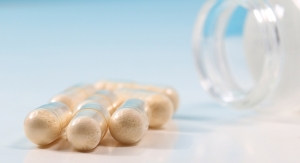02.05.19
Brain imaging research conducted by a team of researchers at the Oregon Research Institute (ORI), led by Eric Stice, PhD, showed that consumption of a lozenge containing gymnemic acid (GA) reduced the desire for high-sugar foods. Participants in the study ate 52% less candy on the day they received the GA lozenge than the day they received the placebo lozenge. Study results were published in Physiology and Behavior.
Forty healthy men and women who reported both a fondness for sweet food and a desire to lose weight participated in this within-subject, double-blind crossover study. Participants attended two functional magnetic resonance imaging (fMRI) scanning visits ≥7 days apart and were served a standardized and healthy breakfast or lunch prior to each test session. They randomly received a gymnemic acid lozenge or a placebo lozenge at their first visit and received the opposite lozenge during their second visit. The 30-minute MRI sessions included the consumption and taste of a high-sugar milkshake and the simple viewing of milkshake images.
"The evidence that blocking sweet taste receptors with gymnemic acids reduces anticipated reward from high-sugar beverages is a very novel finding," noted Stice. "This may be a game-changer regarding approaches for reducing intake of high-sugar foods."
The non-placebo lozenges contained gymnemic acids, a triterpenoid saponin glycoside isolated from the woody vine Gymnema sylvestre, known to suppress the sensation of sweetness by inhibiting sweet taste receptors. The study was the first to use fMRI to test whether the GA lozenge, known as Sweet Defeat, reduces reward region response to tastes of high-sugar food relative to a placebo lozenge.
The focus of the fMRI analysis was on brain regions implicated in reward and reward valuation, including the orbitofrontal cortex, dorsolateral prefrontal cortex, striatum (caudate, nucleus accumbens, putamen), insula, midbrain, and amygdala, as these regions are activated by desire and rewarding experience, such as consuming high-sugar food. Stice and his team focused primarily on these regions to test the hypothesis that the GA lozenges would reduce desire for high-sugar foods.
"It was very exciting that the fMRI findings provided evidence confirming that Sweet Defeat reduces desire for high-sugar foods," said Stice.
Findings
The study results included four unique findings not previously studied using fMRI brain imaging technology.
1) First, the study confirmed that an initial taste of a high-sugar food increased the desire for more as measured by neural response in the caudate region, which has been implicated in reward valuation, as well as regions implicated in related processes such as attention (precuneus). According to researchers, this is the first brain imaging study to provide evidence that an initial taste of a high-sugar food increases desire for more of that food, which may drive overconsumption of high-sugar foods.
2) Second, the study results showed that the GA lozenge decreased activation of brain reward circuitry to tastes of high-sugar food (e.g., nucleus accumbens, insula). This is the first brain imaging study to provide evidence that the GA lozenge reduces recruitment of brain reward regions in response to tasting high-sugar food, researchers said.
3) Third, and perhaps most notably, the study demonstrated that the GA lozenge reduced activation of reward regions (e.g., dorsolateral prefrontal cortex) to anticipated tastes of high-sugar foods, which occurred even before the food was tasted after dosing. This finding is quite important because it provides the first evidence that GA lozenges reduce anticipated reward from high-sugar foods, and that this occurs independent from learning the food tastes less sweet after the GA lozenge dosing. This result suggests that blocking sweet taste receptors reduces anticipated reward from high-sugar foods, even before the high-sugar food is tasted after taking the lozenge.
4) Fourth, participants ate 52% less candy on the day they received the GA lozenge than the day they received the placebo lozenge. This replicated evidence from an earlier experiment that found participants who received a GA lozenge consumed 44% less candy than participants who received a placebo lozenge.
Consumption of high-sugar foods is known to result in weight gain. Obesity is a serious public health problem with nearly 70% of U.S. adults being overweight or obese. Finding a way to reduce desire for sweet treats could be an important step towards decreasing overweight and obesity.
In sum, these findings suggest that Sweet Defeat's GA lozenge not only reduced reward region response to tastes of high-sugar food, but also to anticipated tastes of high-sugar foods. Thus, findings suggest that regular use of Sweet Defeat may help people reduce overconsumption of high-sugar foods, which contribute to excess weight gain and related medical problems (e.g., diabetes) that contribute to elevated morbidity and mortality.
Founded in 1960, Oregon Research Institute is a non-profit behavioral research center with offices in Eugene, OR and in Seattle, WA. Sweet Defeat LLC is creator and manufacturer of the Gymnema lozenges used in this study.
Forty healthy men and women who reported both a fondness for sweet food and a desire to lose weight participated in this within-subject, double-blind crossover study. Participants attended two functional magnetic resonance imaging (fMRI) scanning visits ≥7 days apart and were served a standardized and healthy breakfast or lunch prior to each test session. They randomly received a gymnemic acid lozenge or a placebo lozenge at their first visit and received the opposite lozenge during their second visit. The 30-minute MRI sessions included the consumption and taste of a high-sugar milkshake and the simple viewing of milkshake images.
"The evidence that blocking sweet taste receptors with gymnemic acids reduces anticipated reward from high-sugar beverages is a very novel finding," noted Stice. "This may be a game-changer regarding approaches for reducing intake of high-sugar foods."
The non-placebo lozenges contained gymnemic acids, a triterpenoid saponin glycoside isolated from the woody vine Gymnema sylvestre, known to suppress the sensation of sweetness by inhibiting sweet taste receptors. The study was the first to use fMRI to test whether the GA lozenge, known as Sweet Defeat, reduces reward region response to tastes of high-sugar food relative to a placebo lozenge.
The focus of the fMRI analysis was on brain regions implicated in reward and reward valuation, including the orbitofrontal cortex, dorsolateral prefrontal cortex, striatum (caudate, nucleus accumbens, putamen), insula, midbrain, and amygdala, as these regions are activated by desire and rewarding experience, such as consuming high-sugar food. Stice and his team focused primarily on these regions to test the hypothesis that the GA lozenges would reduce desire for high-sugar foods.
"It was very exciting that the fMRI findings provided evidence confirming that Sweet Defeat reduces desire for high-sugar foods," said Stice.
Findings
The study results included four unique findings not previously studied using fMRI brain imaging technology.
1) First, the study confirmed that an initial taste of a high-sugar food increased the desire for more as measured by neural response in the caudate region, which has been implicated in reward valuation, as well as regions implicated in related processes such as attention (precuneus). According to researchers, this is the first brain imaging study to provide evidence that an initial taste of a high-sugar food increases desire for more of that food, which may drive overconsumption of high-sugar foods.
2) Second, the study results showed that the GA lozenge decreased activation of brain reward circuitry to tastes of high-sugar food (e.g., nucleus accumbens, insula). This is the first brain imaging study to provide evidence that the GA lozenge reduces recruitment of brain reward regions in response to tasting high-sugar food, researchers said.
3) Third, and perhaps most notably, the study demonstrated that the GA lozenge reduced activation of reward regions (e.g., dorsolateral prefrontal cortex) to anticipated tastes of high-sugar foods, which occurred even before the food was tasted after dosing. This finding is quite important because it provides the first evidence that GA lozenges reduce anticipated reward from high-sugar foods, and that this occurs independent from learning the food tastes less sweet after the GA lozenge dosing. This result suggests that blocking sweet taste receptors reduces anticipated reward from high-sugar foods, even before the high-sugar food is tasted after taking the lozenge.
4) Fourth, participants ate 52% less candy on the day they received the GA lozenge than the day they received the placebo lozenge. This replicated evidence from an earlier experiment that found participants who received a GA lozenge consumed 44% less candy than participants who received a placebo lozenge.
Consumption of high-sugar foods is known to result in weight gain. Obesity is a serious public health problem with nearly 70% of U.S. adults being overweight or obese. Finding a way to reduce desire for sweet treats could be an important step towards decreasing overweight and obesity.
In sum, these findings suggest that Sweet Defeat's GA lozenge not only reduced reward region response to tastes of high-sugar food, but also to anticipated tastes of high-sugar foods. Thus, findings suggest that regular use of Sweet Defeat may help people reduce overconsumption of high-sugar foods, which contribute to excess weight gain and related medical problems (e.g., diabetes) that contribute to elevated morbidity and mortality.
Founded in 1960, Oregon Research Institute is a non-profit behavioral research center with offices in Eugene, OR and in Seattle, WA. Sweet Defeat LLC is creator and manufacturer of the Gymnema lozenges used in this study.
























